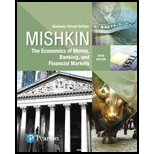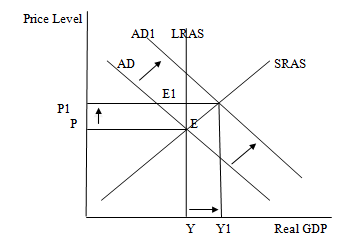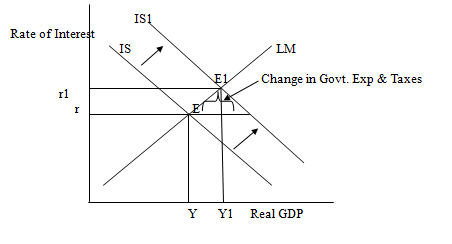
a.The level of change in real
b. The level of change in real government spending and real taxes over the four most recent quarters of data available and the four quarters prior to that.
c. Provide the explanation to answer part a and part b using the IS and AD curves
Explanation of Solution
a. Real GDP: Real Gross Domestic Product
Real Government Expenditure: Real Government Spending
PCE: Personal Consumption Expenditure
[of a quarter of current year w.r.t to the prior quarter of previous year]
b.
[of a quarter of current year w.r.t to the prior quarter of previous year]
[of a quarter of current year w.r.t to the prior quarter of previous year]
| Year
Quarter Month | Real Govt. Spending | Change In Levels of Govt. Spend. | Level of Change in Real Govt Spend % | Real GDP | Change in Levels of GDP | Level of Change in Real GDP % | Federal Govt. Current Taxes Receipts | PCE | Real Taxes =Taxes/PCE * 100 | Level of Change in Real Taxes | Level of Change in Real Taxes % | ||
| 2016 Q1 Jan | 2903.1 | 16571.5 | 2060 | 109.9 | 1874.43 | ||||||||
| 2016 Q2 apr | 2896.3 | 16663.5 | 2096.2 | 110.5 | 1897.01 | ||||||||
| 2016 Q3 July | 2899.9 | 16778.1 | 2131.5 | 111 | 1920.27 | ||||||||
| 2016 Q4 oct | 2901.1 | 16851.4 | 2112.9 | 111.5 | 1894.98 | ||||||||
| 2017 Q1 jan | 2896.6 | -6.5 | -0.22 | 16903.2 | 331.7 | 2.00 | 2133.3 | 112.1 | 1903.03 | 28.60 | 1.53 | ||
| 2017 Q2 apr | 2895.2 | -1.1 | -0.04 | 17031 | 367.5 | 2.21 | 2150.6 | 112.2 | 1916.76 | 19.74 | 1.04 | ||
| 2017 Q3 july | 2899.9 | 0 | 0.00 | 17163.8 | 385.7 | 2.30 | 2176.7 | 112.6 | 1933.13 | 12.86 | 0.67 | ||
| 2017 Q4 oct | 2921.5 | 20.4 | 0.70 | 17286.4 | 435 | 2.58 | No data | 113.4 | No data | No data | No data |
*St. Louis Reserve Fred Database
Interpretation: Findings -
- Real Government Spending is increasing
- Real GDP is increasing
- Real Taxes are reducing
b. Graphs:
Fig1: Effect of Changes in Government Spending & Taxes On Shifts on Aggregate Demand Curve

Short Run Upward moving
Fig2: Effect of Changes in Government Spending & Taxes On Shifts in IS Curve [Investment Saving Curve]

Short run equilibrium is attained between interest rates and output when IS intersects LM curves at point E. Here, Gross domestic product (GDP), or (Y), is placed on the horizontal axis, increasing as it stretches to the right. The nominal interest rate, or (i or R), makes up the vertical axis. If there is an increase in real government spending then the IS curve would shift to the right. ie. when the government spending goes up [when G goes up] it would shift the IS curve to the right and a new equilibrium is achieved at point E1. In the same way, reduction in taxes also causes the IS curve to shift rightward leading to new equilibrium rate of interest and real GDP. This causes an increase in the rate of interest and real GDP as found in the above table.
Introduction:
AD [Aggregate Demand] curve represents the relationship between the inflation rate &
The IS-LM model, which stands for "investment-savings, liquidity-money," is a Keynesian
Want to see more full solutions like this?
Chapter 23 Solutions
Economics of Money, Banking and Financial Markets, The, Business School Edition (5th Edition) (What's New in Economics)
- Not use ai pleasearrow_forwardNot use ai pleasearrow_forwardThe Firm's Output Decision (Study Plan 12.2) Use the following table to work Problems 4 to 6. Pat's Pizza Kitchen is a price taker. Its costs are Output (pizzas per hour) Total cost (dollars per hour) 0 10 1 21 2 30 3 41 4 54 5 69 4. Calculate Pat's profit-maximizing output and economic profit if the market price is (i) $14 a pizza. (ii) $12 a pizza. (iii) $10 a pizza. 5. What is Pat's shutdown point and what is Pat's economic profit if it shuts down temporarily? 6. Derive Pat's supply curve.arrow_forward
- Use the following table to work Problems 27 and 28. ProPainters hires students at $250 a week to paint houses. It leases equipment at $500 a week. The table sets out its total product schedule. Labor (students) 1 Output (houses painted per week) 2 23 5 3 9 4 12 5 14 6 15 27. If ProPainters paints 12 houses a week, calculate its total cost, average total cost, and marginal cost. At what output is average total cost a minimum? 28. Explain why the gap between ProPainters' total cost and total variable cost is the same no matter how many houses are painted.arrow_forwardUse the following table to work Problems 17 to 20. The table shows the production function of Jackie's Canoe Rides. Labor Output (rides per day) (workers per day) Plant 1 Plant 2 Plant 3 Plant 4 10 20 40 55 65 20 40 60 75 85 30 65 75 90 100 40 75 85 100 110 Canoes 10 20 30 40 Jackie's pays $100 a day for each canoe it rents and $50 a day for each canoe operator it hires. 19. a. On Jackie's LRAC curve, what is the average cost of producing 40, 75, and 85 rides a week? b. What is Jackie's minimum efficient scale?arrow_forwardPlease solve this questions step by step handwritten solution and do not use ai thank youarrow_forward
- 1. Riaz has a limited income and consumes only Apple and Bread. His current consumption choice is 3 apples and 5 bread. The price of apple is $3 each, and the price of bread is $2.5 each. The last apple added 5 units to Sadid's utility, while the last bread added 7 units. Is Riaz making the utility-maximizing choice? Why or why not? Do you suggest any adjustment in Riaz's consumption bundle? Why or why not? Give reasons in support of your answer. State the condition for a consumer's utility maximizing choice and illustrate graphically. 2. Consider the following table of long-run total costs for three different firms: Quantity Total Cost ($) Firm A Firm B Firm C 1 60 11 21 2 70 24 34 3 80 39 49 4 90 56 66 5 100 75 85 6 110 96 106 7 120 119 129 Does each of these firms experience economies of scale or diseconomies of scale? Explain your answer with necessary calculations.arrow_forwardRiaz has a limited income and consumes only Apple and Bread. His current consumption choice is 3 apples and 5 bread. The price of apple is $3 each, and the price of bread is $2.5 each. The last apple added 5 units to Sadid's utility, while the last bread added 7 units. Is Riaz making the utility-maximizing choice? Why or why not? Do you suggest any adjustment in Riaz's consumption bundle? Why or why not? Give reasons in support of your answer.State the condition for a consumer's utility maximizing choice and illustrate graphically.arrow_forward1. Riaz has a limited income and consumes only Apple and Bread. His current consumption choice is 3 apples and 5 bread. The price of apple is $3 each, and the price of bread is $2.5 each. The last apple added 5 units to Sadid's utility, while the last bread added 7 units. Is Riaz making the utility-maximizing choice? Why or why not? Do you suggest any adjustment in Riaz's consumption bundle? Why or why not? Give reasons in support of your answer. State the condition for a consumer's utility maximizing choice and illustrate graphically.arrow_forward

 Principles of Economics (12th Edition)EconomicsISBN:9780134078779Author:Karl E. Case, Ray C. Fair, Sharon E. OsterPublisher:PEARSON
Principles of Economics (12th Edition)EconomicsISBN:9780134078779Author:Karl E. Case, Ray C. Fair, Sharon E. OsterPublisher:PEARSON Engineering Economy (17th Edition)EconomicsISBN:9780134870069Author:William G. Sullivan, Elin M. Wicks, C. Patrick KoellingPublisher:PEARSON
Engineering Economy (17th Edition)EconomicsISBN:9780134870069Author:William G. Sullivan, Elin M. Wicks, C. Patrick KoellingPublisher:PEARSON Principles of Economics (MindTap Course List)EconomicsISBN:9781305585126Author:N. Gregory MankiwPublisher:Cengage Learning
Principles of Economics (MindTap Course List)EconomicsISBN:9781305585126Author:N. Gregory MankiwPublisher:Cengage Learning Managerial Economics: A Problem Solving ApproachEconomicsISBN:9781337106665Author:Luke M. Froeb, Brian T. McCann, Michael R. Ward, Mike ShorPublisher:Cengage Learning
Managerial Economics: A Problem Solving ApproachEconomicsISBN:9781337106665Author:Luke M. Froeb, Brian T. McCann, Michael R. Ward, Mike ShorPublisher:Cengage Learning Managerial Economics & Business Strategy (Mcgraw-...EconomicsISBN:9781259290619Author:Michael Baye, Jeff PrincePublisher:McGraw-Hill Education
Managerial Economics & Business Strategy (Mcgraw-...EconomicsISBN:9781259290619Author:Michael Baye, Jeff PrincePublisher:McGraw-Hill Education





